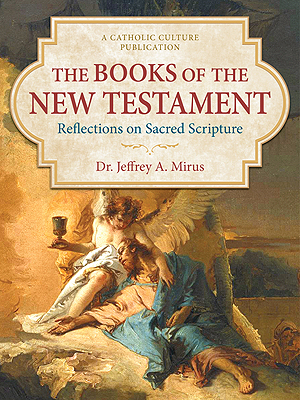Warning: Fake News
By Phil Lawler ( bio - articles - email ) | May 23, 2025
The term “fake news” is used far too often today. A news story is not a “fake” simply because it expresses a different opinion, or offers a different perspective, or even leaves out important context. Such stories may be wrong-headed or even downright wrong, but they are not fake.
Still there is (if you’ll pardon the expression) genuine fake news: reports that have no basis in reality. The rising power of social media has made it easy to perpetrate journalistic fraud, giving wide circulation to reports on events that never actually occurred.
With the development of artificial intelligence (AI) tools, now available to anyone online, fake news has become much easier to produce in realistic forms. Documents can be readily forged or altered; audio and video recordings can be edited. Armed with AI, a determined hacker could produce a video in which I appeared to confess to the assassination of the Archduke Franz Ferdinand. The image would be my face; the voice would be my voice—cut and pasted from other videos. But of course the confession would be false. (Honest. I didn’t do it.)
Since the election of Pope Leo XIV there has been an explosion of “fake news” stories involving the papacy. Most of the online reports have been “quotations” of things that the Pope never said, obviously posted by people who wanted to claim papal support. But this week the Vatican News service took the unprecedented step of exposing a more ambitious bit of fake news: a a videotape that purported to show Pope Leo lavishing praise on the president of Burkina Faso. The fraud was skillfully done, along the lines indicated above. The image was the Pope’s image; the voice was the Pope’s voice. But the content was definitely not the Pope’s message.
When I founded Catholic World News (CWN), more than 30 years ago—long before AI was a realistic prospect, let alone a reality—I saw a need for coverage of news stories that the mainstream media either skewed or ignored altogether. At that time I observed that the stories the media do not cover are often more important than those they do. While liberal bias in the major media was and still is pervasive, and many stories are presented in misleading ways, at least those stories are presented. But what about those stories the mainstream media chooses to ignore? Silence is not “fake news,” but it can have the same effect.
Now, however, we face the opposite sort of problem as well. While the traditional media organs ignore important stories, upstarts on the internet produce “news” about things that did not happen. As more and more people rely on the internet for their news, in the Wild West of blogs, podcasts, and social media, fraudulent stories spread quickly.
Already, in his first few weeks in office, Pope Leo has made several public references to the moral challenges involved with AI. (There is some irony, then, in the fact that he appears to be among the first major victims of its misuse.) There is surely a need for moral guidance in this rapidly growing sphere.
Computers cannot think, in the sense that we think; they cannot reflect. But given enough bandwidth they can sort through information much faster than we can, with our limited mental capacities. Properly programmed, they never forget or miscalculate, as we do. They excel at recognizing and reproducing patterns.
It is this last characteristic, the ability to imitate patterns, that is a key to the emergence of AI in the creation of fake news. In the past, computers could generate false news stories. Now, with the powerful help of AI, they can make those stories look plausibly like the real thing.
Several years ago, reading a long paper submitted by a college student, I noticed that midway through the assignment, the writing style changed. Alarm bells rang; the question naturally arose: Had he done all of this work himself? I was relieved, in an odd way, to see that even after the change in style, the same characteristic grammatical errors continued. The whole paper was obviously written by the same person, with the same shaky grasp of English usage. (Eventually I concluded that the difference in prose style was probably due to a lack of sleep and an excess of caffeine.) Today, no doubt, a sophisticated AI program could mimic that student’s eccentric syntax. Prudent teachers now realize that they probably cannot detect fraud in a research paper—at least not from the evidence of the paper itself.
AI is a wonderful tool. Just this week I used Grok to find the text of an address that then-Cardinal Ratzinger delivered more than 30 years ago. With AI assistance, the search that might have taken many hours was done in less than a minute. And Grok stood ready to translate the address into any language I chose. For that sort of research help, I am grateful.
Along with that appreciation comes a sense of danger. Teachers have already begun to respond to the challenge of AI. Maybe the realities of academic life in the age of AI will force schools to recover a proper appreciation for the value of classroom participation, oral reports, and one-on-one examinations to complement the standardized tests and research papers.
Unfortunately the same cannot be said for those of us who produce and relay news stories. We have not yet learned how to combat the proliferation of fake news. At a time when traditional news outlets have lost the confidence of the public, and new online purveyors have not yet established their credibility, readers face a new sort of challenge. Yes, by all means browse the alternative news sites. But don’t take their accuracy for granted. Buyer beware.
All comments are moderated. To lighten our editing burden, only current donors are allowed to Sound Off. If you are a current donor, log in to see the comment form; otherwise please support our work, and Sound Off!
-
Posted by: ewaughok -
May. 30, 2025 7:18 PM ET USA
It’s common nowadays — because AI extraordinarily burst on the scene — for many people to denounce the AI algorithms themselves as if they were the devil. It’s little remarked, that these algorithms when found to be doing criminal or unethical activities, are being trained and used by people to do these immoral deeds. AI is just a tool, it’s the people using them who are immoral. How similar to the way some gun control policies blame the gun rather than the wicked human person using the gun!
-
Posted by: feedback -
May. 24, 2025 2:10 AM ET USA
I would only hope that the proliferation of AI-created fake news will make more people aware of the widespread problem of all kinds of politically motivated hoaxes reported as "the news." Whether AI-generated or not.








